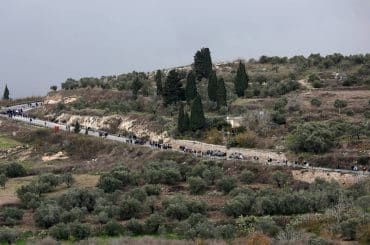
On August 5, The New York Times published a highly problematic article “Civilian or Not? New Fight in Tallying the Dead from Gaza Conflict”, that presented information supporting dubious Israeli government claims that 900 Palestinians killed by Israel in Gaza, or around half of all Palestinian killed in Gaza in Israel’s current offensive, were “terrorists.” This assertion flies in the face of consensus reporting over the last month indicating much higher Palestinian civilian casualty figures.
Yet another example of bad New York Times’ reporting on Gaza, the article by Times Jerusalem Bureau Chief Jodi Rudoren deserves debunking on many levels. It is built on unsupported claims by the Israeli government about whom Israel killed. Rudoren’s article fails to explain consensus positions in international law on who is a combatant, or explain Israel’s position on them. It also presents information in a way that profiles all Palestinian males age 15 – 60 as possible terrorists potentially deserving of death, and inappropriately limits the age of children to 0-14 years. More broadly, Jodi Rudoren’s article supports an Israeli government PR push to revise the history of Israel’s attack on Gaza to make Israel look better by asserting that Israel killed far more combatants and far fewer children than has been widely reported.
The article demonstrates The Times’ inability to hold itself accountable to basic standards of accuracy and fairness in reporting on Israel and Palestine.
Careful research and unsupported Israeli government assertions get equal weight
Greg Mitchell dismantled a number of Rudoren’s assertions in his blogpost, “Rudoren to the Rescue on Civilian Toll.” Her article lends credibility to very dubious Israeli government claims about Palestinian civilian deaths. It does so by giving the same weight to painstakingly compiled research by the United Nations, and independent Palestinian human rights organizations in Gaza that concluded that 72% – 84% of those killed in Gaza by Israel were civilians, as it does to the unsupported Israeli government claims that roughly half the dead in Gaza were combatants. The only evidence that Rudoren provides to back the Israeli government claims are “368 cases listed in 28 entries” on the Israeli military’s blog, and “a study by an Israeli counterterrorism group that is impressive in its documentation… but analyzes only the first 152 casualties.”
Despite her minimal information on how Israeli intelligence arrived at the assertion that 50% of Gazans killed were combatants, Rudoren presents the conclusion that the Israeli government draws from it unsupported claims – “the ratio of combatants killed in a densely populated urban environment supports its assertion that it conducted the attacks as humanely as possible.” She then takes this fact-free analysis even further, suggesting that a lower than widely reported Palestinian civilian death rate might change “the characterization of the conflict.”
Failure to detail international law consensus vs. Israeli positions on who is a combatant
On the Just Security blog, Ryan Goodman, a Professor of Law at the NYU School of Law, took Rudoren to task for her failure to delve further into a key question that she raised in her article, who is a combatant? Different definitions of who is a combatant likely explain an important part of the difference between Israel’s 50% combatants killed versus 16% – 28% combatants killed reported by Palestinian NGOs and the UN. Goodman criticizes Rudoren’s article for failing to ever note the very broad consensus on who qualifies as a combatant under international law. There is a stark difference between that international consensus and Rudoren’s ambiguously sourced, possibly Israeli government claim that Hamas has “political figures, members of its security service and employees of its ministries,” and that “anyone affiliated with the organization [Hamas], which professes a goal of destroying Israel, is a combatant.”
Profiling all Palestinian men as potential combatants deserving of execution
Rudoren’s analysis suggests that all Palestinian males in Gaza between the ages of 15-60 are suspects – potential combatants who may deserve to be killed. The article notes that, “34 percent of those killed in Gaza from July 6-31 were children, women, elderly or female victims of an unknown age. The remaining deaths were a mix of male civilians and combatants, though breakdowns are disputed. “ The statistics in the graphic accompanying the article demonstrate that the 34 percent includes only children between the ages of 0-14 years, and does not include 15-17 year olds. Thus boys as young as 15-years-old fit into Rudoren’s “mix of male civilians and combatants.” Also falling within Jodi Rudoren’s “mix of male civilians and combatants, though breakdowns are disputed” would be Anwar al-Za’anin, a staff member of Al Mezan Center for Human Rights, who was killed yesterday by an Israeli drone, and health worker Mohammad al-Abadlah, 32, just two of many examples.
Perhaps worse, Jodi Rudoren states that if you are a Gazan male between the ages of 20-29, you are part of “the population most likely to be militants.” I doubt that most of the roughly 153,000 Palestinian men in Gaza who are between 20-29-years-old appreciate the title “most likely to be militants” bestowed on them by The New York Times. Nor would they appreciate that they are “most likely” targets for Israel, as were 23-year-old Salem Shamaly who was shot dead by an Israeli sniper while searching for family members, journalists Sameh Al-Aryan, 26, of Al-Aqsa TV, and Rami Rayan, 25, who worked for the Palestinian Media Network, both killed by Israeli shelling of the Shija’iya market, and health worker A’ed Al-Bor’i, 28, who was killed by an Israel shell while riding in an ambulance with an injured person.
Rudoren’s only somewhat original research in the article shows that “the population most likely to be militants, men ages 20 to 29, is also the most overrepresented in the death toll. They are 9 percent of Gaza’s 1.7 million residents, but 34 percent of those killed whose ages were provided.” The implication is that perhaps this shows that Israel really did kill a much larger number of Palestinian militants than has been recognized. But Rudoren fails to investigate other likely explanations. Yes, Israel did kill some Palestinian fighters, but on the other hand young Palestinian men are much more likely to be out in public and exposed. Furthermore, Israel profiles younger Palestinian men as likely fighters, whether or not they are, and thus is much more likely to kill them than others.
Rather than relying on actual on-the-ground research into who among those killed did what, and thus who qualifies as a civilian or a combatant, The Times article lends significant weight to Israel’s crude profiling of men, and even of male children, in Gaza, categorizing dead Palestinian males, with no evidence, as combatants who merited their deaths.
Untenable definition of who is a child in Gaza
The article also falters over a clear and uncorrected factual error about who is a child in the graphic, “One Count of Gaza Casualties.” The graphic is important because it furnishes summary statistics used in the article for analysis. A graph in the article separates The Times’ data on Gaza casualties into four broad categories: Children (0 – 14 years), Women or Men (15 – 59 years), Elderly (60 – 80+ years) and Unknown.

15 – 17-year-olds are included under the category Women or Men, rather than with Children. As noted earlier, the graphic and analysis also place male children aged 15-17 into one of The Times categories of suspects, within the “mix of male civilians and combatants.” None of this can be easily justified. Outlining a widely accepted definition, the UN’s Convention on the Rights of the Child (CRC) notes, “a child means every human being below the age of eighteen years unless under the law applicable to the child, majority is attained earlier.” Most governments use roughly similar ages to those in the CRC for their upper age limit for children.
By email, The Times’ Standards Editor Greg Brock quickly rejected without explanation my assertion that the graphic needed correction because it incorrectly limited children to ages 0-14 years. Brock was continuing a pattern of problematic corrections on Israel and Palestine that I and others have documented.
Jodi Rudoren responded by email with explanations that never adequately explained why the graphic represented “Children” as 0-14 years, and “Men” and “Women” as 15 years and over. Rudoren wrote in part,
“Here’s the problem with your complaint: it is not based on our actual graphic. We did not label anyone in the graphic as ‘adults.’ The word does not appear. In general, in articles, we refer to people ages 15-18 as teenagers, not as children — and I think that is more accurate, more understandable. Many demographers also do not call everybody under 18 ‘children’ but minors. Remember, though, we are not bound by some official characterization.”
But shouldn’t The Times be bound by some logically consistent characterization? Rudoren is correct that the graphic didn’t explicitly label anyone as adults. But the graphic very clearly limited Children to 0-14 years. There is a clear separation, with “Men” and “Women” beginning at 15 years. Whether or not the terms Men and Women imply adulthood (I think they do), 15-17-year-olds were classified very clearly with older people who are unequivocally understood to be adults. They also were not classified anywhere in the graphic as “teenagers,” so Rudoren’s argument about a distinct teenager category is irrelevant.
In a second email, Rudoren added, “Even the labels “women” and “men” were placed far from the teenagers.” But the distance in the graphic between “Women” and “Men” and the ages 15-17 or 18 is also not relevant, because the labels “Women” and “Men” very clearly cover the ages 15-19.
The graphic represents 15-17-year olds or 15-18-year-olds as men or women, and not children. But even the article itself doesn’t make that argument consistently. Instead the text twice mentions the category, “children under 15.” Noting “children under 15,” implies that there are also “children” who are 15, and perhaps older.
Further undermining Rudoren’s claim that The Times labels 15-18-year olds as teenagers and not children is a January 2014 Times Editorial that I located entitled “When Children Become Criminals.” The editorial begins, “New York is one of two states, the other being North Carolina, in which 16-year-olds are automatically tried as adults. This is the case despite overwhelming evidence that sending children into adult courts…” This Times editorial never used the term teenagers as it recommended changes to the legal system for 16 and 17-year-olds, all under a title focused on “children.”
In an odd, and very troubling follow-on, on August 9 Jodi Rudoren reported that “more than 300 children” had been killed in Gaza. She did so at a time when the UN was reporting 415 children killed. The Times reporting of one hundred fewer dead children than the UN and other sources would seem to be explained by The Times continued use of this more limited and inaccurate definition of children.
Thus, as examples, Osama Mohammad Sihweil, 16, from Beit Hanoun, Ala Khader Ramadan Salman, 17, from Beit Lahia, Aseel Saleh Hussein Abu Mohsen, 17, Ismail Samir Suleiman Shallouf, 16, Yousef Akram Saleh al-Skafi and Amro Tareq Said Abu al-Rous, both 15, all from Rafah, whose deaths are recounted in this statement from Defense for Children International Palestine, all do not count in The New York Times “unique” tally of children killed in Gaza.
By using its own, unorthodox definition of Palestinian children, one different from other media and authorities, The Times is redefining downward the number of Palestinian children that Israel killed in Gaza, while conversely increasing the number of men who may be considered combatants who were killed. Such reporting “supports its [Israel’s] assertion that it conducted the attacks as humanely as possible,” and contributes to possibly helping to change “the characterization of the conflict.”
Supporting an Israeli Government Public Relations Campaign
I said in my emails to The Times that the article’s approach fit well with Israeli government talking points and that “the Israeli government has launched a concerted PR campaign to claim that as many Palestinian civilian casualties as possible in Gaza, including children, were in fact somehow deserving of being killed by the Israeli army. Ms. Rudoren’s article and the accompanying graphic came within that context.”
Jodi Rudoren responded by email: “As for Israeli talking points, this is nuts. The Israelis basically refused to provide any information for this story, as noted.”
Yet Rudoren framed her story as a “new fight” between “Israel” and “Palestinians and their supporters” over the number of civilians killed (evidently their supporters include the UN, as Greg Mitchell noted). Thus the story is by definition in part a presentation of Israeli government positions, including a 50% Palestinian combatant death toll and a humane as possible Israeli assault on Gaza. That the Israeli government is waging a PR campaign to push these positions in the media was emphasized by the fact that Reuters and The Gatestone Institute published articles just before Rudoren’s piece, and the Associated Press published an article a few days after, all covering these same issues. The BBC, and I24 then followed with similar articles.
Furthermore, labeling older Palestinian male children as potential combatants, and profiling all Palestinian males as potential combatants regardless of their actions, as Rudoren did in this story, is a longstanding Israeli government practice. As just one recent example, after initially being brutally beaten by Israeli police and accused of involvement in violence against Israeli police, 15-year-old Palestinian American Tariq Abu Khudeir was later released without charges, following substantial media attention. Tariq, a child and an innocent victim, was accused by Israel of being the violent attacker. Before his release, The Times had quoted an Israeli Police spokesperson explaining that “Tariq was one of six Palestinians arrested — three of them carrying knives — after a clash in which 15 officers were injured when ‘hundreds of rioters, many of them masked, hurled at the forces pipe bombs, Molotov cocktails, fireworks and stones.’”
* * *
This dreadful New York Times news story is just one example of The Times’ systematically biased reporting on Israel and Palestine. On August 2, I posted a more comprehensive rundown of The Times bad reporting on Israel’s attack on Gaza. Since then, The Times published two good articles by Anne Barnard and Ben Hubbard of the sort they should have been publishing daily, but those were then followed by this article by Rudoren.
Bias in Rudoren’s reporting may not surprise some. She has described herself as being criticized as “kind of entrenched in the Israeli-Zionist-Jewish-American perspective… I live in West Jerusalem [and] spend quite a bit of time in my office there. I wish I spent much more time in the West Bank than I do.” She and her husband Gary Rudoren’s apparent lack of contact with Palestinians and their concern about “the Arabs” were displayed in a recent 56 minute video about the family’s life in West Jerusalem. Max Blumenthal reported in the Electronic Intifada, “the only time any Palestinian speaks in the nearly hour-long video is when Gary Rudoren sends his dirty clothes to a local laundromat.” A Palestinian (or “Arab”) receives his laundry.
Still, there are Times’ editors supervising Rudoren, reviewing story ideas, editing her pieces and coming up with the frequently awful titles for her articles. There are also editors who sometimes refuse to make appropriate corrections to her pieces. As much as bad reporting by individuals deserves attention, it’s likely underpinned by a more widespread bias at The Times that supports the perpetuation of Israeli Jewish privilege at the expense of basic Palestinian rights.


“Boys to men– ‘New York Times’ tally of Gaza dead says 15- to 17-year-old’s aren’t children”
Unless they are Israeli teens(one was nineteen) allegedly murdered by Hamas.
Strange how that logic finds a space in the Zionist mentality.
Readers of this column should refresh their memories of Phil Weiss great column on Ms. Rudoren’s New York times article implying Gazans are ho hum about the death of relatives. Gives good context for her stripping away three years from the childhood of Gazan and Palestinian children, while Israeli adolescents do not attain mature, legally mandated adult status until eighteen. I believe this is also the policy or practice in the military courts in the territories. https://mondoweiss.net/2012/11/gazans-have-aspiration-to-martyrdom-and-have-such-limited-lives-that-they-have-less-to-lose-than-israelis-nyts-rudoren.html
Of course the kidnapped and murdered Israeli settlers (ages 17-19, as I recall) were referred to as “boys.”
I am utterly astonished at what is coming out in the papers, people trying to rationalise genocide. It is pure horror, no horror movie comes close to depicting what is becoming reality.
Well. In the 0-4 year ages, Israel did not discriminate between M/F (is this a comfort?). Now can NYT, or Oren, explain why 5-9 years olds are killed extremely segregated by M/F?